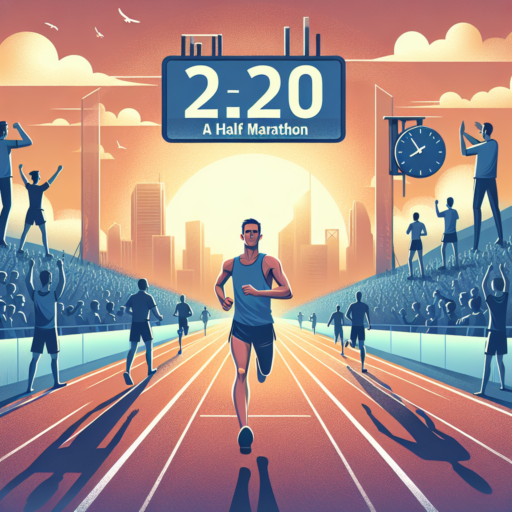What pace do I need to run a half marathon in 2 hours?
Aiming for a half marathon finish in under 2 hours is a common and ambitiously achievable goal for many runners. To break this barrier, understanding the required pace is crucial. Essentially, to complete 13.1 miles (about 21.1 kilometers) in this timeframe, you need to maintain an average pace of approximately 9 minutes and 9 seconds per mile (or about 5 minutes and 41 seconds per kilometer). This pace is a blend of endurance and speed, demanding consistent effort and a well-thought-out race strategy.
Training for Your Target Pace
Successfully hitting your desired pace on race day begins with structured training. Incorporate interval training, long runs at a slightly slower pace than your target, and pace runs at your goal speed to condition your body. Focus on building endurance and speed gradually to avoid injury and burnout. Remember, consistent training over weeks and months is the key to achieving your 2-hour half marathon goal.
Nutrition and Recovery
Equally important to your training regimen is your approach to nutrition and recovery. Fueling your body with the right nutrients pre and post-run aids performance and recovery. Stay hydrated, consume a balanced mix of carbohydrates, proteins, and fats, and don’t skimp on sleep. Giving your body time to rest and recover is essential, especially after hard workouts.
No se han encontrado productos.
Can I run a half marathon if I can run 10K?
Many runners find themselves pondering the question, «Can I run a half marathon if I can run 10K?» This common query surfaces particularly as individuals begin to feel more comfortable and confident over shorter distances and look to challenge themselves further. The progression from a 10K to a half marathon is a significant leap, considering a half marathon measures just over 21 kilometers, doubling your 10K distance. However, with the right approach, training, and mindset, making this leap is entirely possible.
The journey from running 10K to conquering a half marathon requires a tailored increase in mileage, attention to recovery, and possibly changes to nutrition and hydration strategies. One key strategy involves gradually increasing your long-run distance each week. For someone who can comfortably run 10K, this might mean adding an extra 1-2 kilometers to your longest run each week, thereby building up endurance over time without overwhelming the body.
Additional Training Considerations
Additional elements that play a crucial role in successfully transitioning from 10K to a half marathon include strength training and cross-training. Incorporating activities like cycling, swimming, or using an elliptical machine can boost cardiovascular fitness while reducing the risk of injury from overuse. Strength training, particularly exercises that target the core, legs, and glutes, can improve running efficiency and endurance. This comprehensive approach ensures that your body adapts to the increased demands of half marathon training in a balanced and sustainable manner.
What is a 3 hour half marathon pace?
Cracking the 3-hour mark in a half marathon is a significant benchmark for many runners, representing not only a physical but also a mental achievement. The pace required to accomplish this feat is a convergence of endurance, strategy, and consistent training. To attain a half marathon finish time of 3 hours, one must maintain a pace of approximately 13 minutes and 44 seconds per mile (or about 8 minutes and 32 seconds per kilometer). This calculation is based on the half marathon distance of 13.1 miles (or 21.1 kilometers).
To sustain such a pace, runners need to develop and follow a tailored training program that incorporates various types of runs, including long runs, speed workouts, and tempo runs. Furthermore, proper nutrition, hydration, and recovery practices are crucial components that will support the physical demands of this running pace. Achieving a 3-hour half marathon also demands mental resilience, as runners are often challenged to push through physical discomfort and mental fatigue.
It’s essential for athletes aiming for this milestone to monitor their progress with practice races or time trials, adjusting their strategies as needed. Runers should pay close attention to their body’s cues and adjust their pace accordingly to avoid burnout or injury. Equipping oneself with the right running gear, especially shoes that offer sufficient support and cushioning, can also make a significant difference in performance and comfort during the race.
How do you calculate pace for a half marathon?
Calculating your pace for a half marathon is essential for setting realistic goals and understanding your current fitness level. A half marathon, which spans 13.1 miles or approximately 21.1 kilometers, requires a blend of speed and endurance. To determine your pace, you’ll need to divide the total running time by the distance you’ve run. The formula looks simple: pace = total time / distance. For example, if you plan to finish a half marathon in 2 hours, your pace would be approximately 9:09 minutes per mile or 5:41 minutes per kilometer.
Incorporating pace calculators available online can also simplify this process. These tools only require your input on the distance and your goal time, doing the math to provide your expected pace. This method is particularly helpful for runners who prefer focusing on their training rather than the calculations.
Understanding your desired pace allows for more structured training sessions. By breaking down the half marathon into smaller segments, like miles or kilometers, you can focus on maintaining or gradually improving your pace during practice runs. This incremental approach fosters both physical and mental preparedness for race day, keeping the pacing objective clear and attainable.




